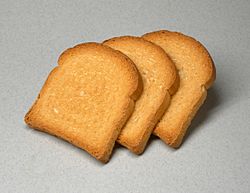Zwieback facts for kids
 |
|
| Type | Bread |
|---|---|
| Place of origin | Germany |
| Region or state | East Prussia |
| Main ingredients | Flour, eggs, sugar |
Zwieback is a special kind of bread that's baked twice! It's a crispy, slightly sweet snack enjoyed in many countries, especially in Europe. Think of it like a very crunchy toast or a dry biscuit.
What is Zwieback?
Zwieback is a type of rusk, which means it's a dry, hard biscuit or bread. It is made with flour, eggs, and sugar. The bread is baked, then sliced, and baked again until it's very crisp. This double-baking process makes it last a long time.
You can find Zwieback in many places around the world. It is popular in countries like Germany, Poland, and many others across Europe. It's also eaten in Canada and the United States.
A Brief History
Zwieback first came from a place called East Prussia, which is now part of Poland and Russia. Some people believe it was invented by a general named Albrecht von Wallenstein. He needed a food that would last a long time to feed his army during a big war called the Thirty Years' War. This war happened a long time ago, from 1618 to 1648.
Later, a group of people called the Mennonites helped spread Zwieback. They moved from the Russian Empire to places like Canada and the United States. When they moved, they brought their traditions and recipes, including Zwieback, with them.
Different Kinds of Zwieback
There are two main types of Zwieback:
- Soft Zwieback: This type is often linked to the Mennonites. It's made by taking two small, round pieces of dough. One piece is placed on top of the other. Then, a finger is pushed down through both pieces to press them together. This creates a unique shape. These are baked and served as warm, soft rolls.
- Crispy Zwieback: This is the more common type. It's made like a regular loaf of bread. After the first bake, the bread is sliced. These slices are then baked a second time until they become very crisp and brittle. They look a lot like melba toast.
Crispy Zwieback is often given to teething babies. It's hard enough for them to chew on, which can help their gums. It's also a common first solid food for people who have an upset stomach. It's easy to digest because it's so dry and simple.
Why is it Called Zwieback?
The name "Zwieback" comes from the German words zwei (meaning "two") or zwie (meaning "twi-", like "twice"). The second part, backen, means "to bake". So, "Zwieback" literally means "twice-baked"!
Other languages have similar names for this type of food:
- In French, it's called biscotte.
- In Italian, it's fette biscottate.
- In Slovene, it's prepečenec.
- In Serbo-Croatian, it's dvopek.
All these names also mean something like "twice-baked" or "baked over," showing how important the double-baking process is.

